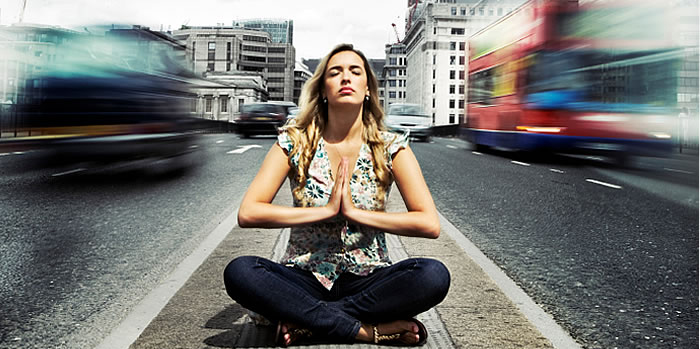Breathe Girl, Breathe: A Beginner’s Guide to Meditation
Scattered. That’s how I felt during the beginning of graduate school. Between adjusting to a new city and country, constant marathon-length group meetings, and sporadic eating habits (not a good combination for an introverted hypoglycaemic), I developed mental fatigue like no other. I was often exhausted, at a loss for words, and had difficulty concentrating, which was un-Erin-like. In fact, I felt like Kanye West’s BBC interview: totally off-kilter.
Once I had downtime, I refocused on my health. I got more sleep, ate at regular intervals, and took advantage of my university’s gym. However, something was still off. After some research, I found another option, which has since helped me tremendously.
(Image via)
Meditation.
Long regarded as a tradition for monks, meditation has emerged as a mainstream practice. Celebs from Oprah and Eva Mendes to Russell Brand and Russell Simmons meditate. Corporations are also turning to it to boost productivity. Meditation’s benefits are plentiful: it’s been noted not only to lower stress and increase concentration, but also to boost immunity and creativity. Despite its benefits, the practice is often seen as inconvenient or ineffective. So, how do you set a meditation routine AND get results?
Find your preferred type
There’s no one-size-fits-all approach to meditation. There are literally hundreds of forms, which may involve anything from Christian prayer, laughter, or visualisation. However, most types of meditation fall into two major categories: concentration and mindfulness.
Concentration meditation involves concentrating on a single thing until the mind becomes still. This may involve repeating a mantra or focusing on a particular sound, image, or object. Mindfulness meditation takes into account multiple things that you may be experiencing at the moment. This may involve spending time focusing on your breath, then transitioning to focusing on noises around you or noting your thoughts.
You may also want to consider meditative movement practices. These include Tai Chi, Qigong, and Yoga styles that focus on breathing and meditation, such as Kundalini.
Set a length and frequency
Meditation can often be perceived as time consuming, and people may struggle to figure out how to fit it into their day. But meditation sessions don’t have to be long. In fact, as little as five minutes can be beneficial. As a beginner, try to start with 10-minute meditation sessions and work your way up to 20 minutes (or more if you wish).
You may also prefer to have multiple sessions during the day, such as a session right after you wake up in the morning and another once you settle in during the evening. Either way, aim to make it a daily habit. A short meditation done at least once a day is more effective than long sessions done only a couple of times per week.
One thing to keep in mind is not to over meditate, which can cause spaciness and clumsiness. Listen to your mind and body. Too much of a good thing isn’t ideal, meditation included.
Find a comfortable setting
This may involve meditating in a quiet space inside your home, at your desk during a short work break, or in nature. You may also prefer to only meditate alone or supplement your practice with a group class. Either way, ensure that your space isn’t too distracting and you don’t feel restricted in clothes that are too uncomfortable. Additionally, you may want to sit either upright in a chair or cross-legged on a floor cushion. Just avoid lying down if you’re prone to dozing off.
These are just a few things to consider when you’re starting meditation. Some free programmes that you may want to use for further exploration are: Meditation Oasis, Headspace (the first 10 days are free), UCLA’s podcasts, the Chopra Center‘s podcasts, and the Law of Attraction Centre’s Meditation 101 Live.
Remember: Don’t strive for perfection in meditation. It’s okay if your mind wanders. And it’s okay if you don’t practice at the same time or place during every session. What matters is that you’re integrating it into your day.
So breathe girl, breath.
Tags: breathing meditation relaxation Stress
Categories: Erin Johnson Wise up!

1 Comment
Wow article for beginner guid for Meditators.